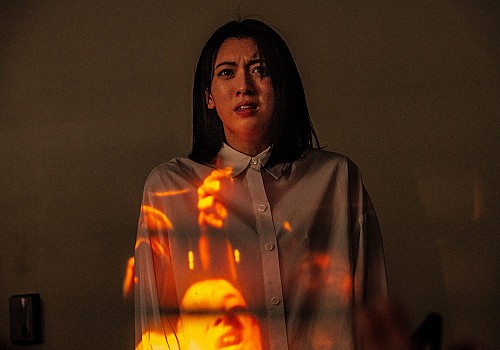Takashi Shimizu, the director and co-writer (with Daisuke Hosaka) of Howling Village (Inunaki-mura), will always, along with Hideo Nakata (Ring, 1998; Dark Water, 2002) and Kiyoshi Kurosawa (Pulse, 2001), belong to the pantheon of J-horror filmmakers.
This comes down to Shimizu’s auteurist rôle at the centre of one of this subgenre’s most famous and influential cycles, the Grudge series, whose creepy, contorting reven(ge)ant Kayako and her meowing son Toshio were first introduced in Shimizu’s three-minute shock films Katasumu and 4444444444 (both made for the TV anthology Gakko no Kaidan G in 1998). The viral popularity of these characters meant that Shimizu was able to expand their stories first into the feature-length ‘V-cinema’ films Ju-on: The Curse and Ju-on: The Curse 2 (both 2000), then into the theatrical features Ju-on: The Grudge (2002) and Ju-on: The Grudge 2 (2003), and finally into a series of American reimaginings (the first two of which, from 2006 and 2009 respectively, were still helmed by Shimizu himself). Since then he has passed the Grudge baton to other directors, with more sequels and spin-offs (like Koji Shiraishi’s crazy cross-over from 2016, Sadako vs Kayako), and recently a second American reimagining/reboot/rewhatever directed by Nicolas Pesce (Piercing, 2018).
So Shimizu will always be celebrated for being absolutely pivotal in the birth and early nurturing of an iconic horror franchise. Ever since, Shimizu has broadly stuck to the horror genre – with the occasional foray elsewhere, like his live-action version of Kiki’s Delivery Service (2014) – but much as the glory days of J-horror have long since receded, Shimizu’s own star, however bright it may once have shone, has now also somewhat dimmed as other trends take over. In many ways, Howling Village exemplifies this – a film that, had it come out in the early Noughties, would no doubt have been embraced and feted, but which now feels just a little dusty and old-fashioned. The opening sequence, introducing found footage (shot on a character’s smartphone), an urban myth about cursed calls from an isolated phone booth at 2am, a creepy tunnel and a hidden village beyond full of ghosts (human and canine), and a grotesque, paradoxical suicide, plays out almost like a pastiche of J-horror tropes.
Yet a backward-looking sensibility need not be a bad thing for a ghost story, and Howling Village is all about a past that keeps resurfacing. Shortly after Akina (Rinka Otani) enters the mysterious ‘Howling Village’ at night with her boyfriend Yuma (Ryota Bando), she dies on land with her lungs bizarrely full of water, and Yuma himself and his little brother Kota go missing while trying to reenter the village. Yuma’s older sister Kanade (Ayaka Miyoshi) – a child psychiatrist who, like her late grandmother, can see ghosts – finds herself increasingly drawn into local legend concerning not only a village submerged back in 1949 as part of a hydroelectric dam scheme, but also the checkered genealogy of her own family. Here, as in TV’s The Returned, a town is haunted by a sunken history that it has never fully sealed up. The grudge-filled ghosts that embody its past sins also seek to continue their cruelly severed bloodline, however irrationally, from beyond the grave. Caught in the middle of her divided community, Kanade is not sure whether to fear and flee the vengeful spirits all around, or to embrace them as the wellspring of who she is today.
Accordingly, Howling Village is concerned with keeping the past alive – and this is something that it also does with its own generic makeup, respectfully resurrecting routines from buried J-horror to show a Japan still struggling to emerge from a harrowing history that can never be fully suppressed. It features some memorable set-pieces, including men trapped in a phone booth (echoing Antonio Mercero’s 1972 short TV film La Cabina) – and the ghosts themselves are presented as juddery dark smudges that phase-shift through a location, or as angular canine vampires that move like butoh dancers. Gone is the raw terror of the Grudge films, but in its place is a convoluted story about the different ways in which a community lives – or dies – with the misdeeds of yesteryear, carried out in the name of ‘progress’. Some things, you see – J-horror included – never fully die, but are reborn in each successive generation.
Howling Village was seen and reviewed at Fantasporto 2020.
